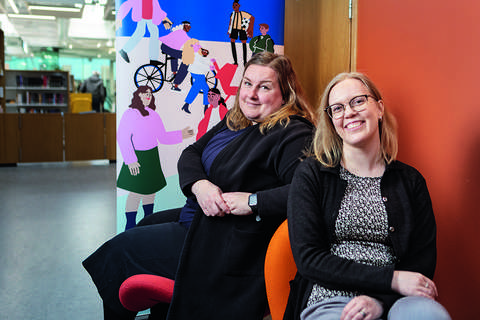Finland’s best integrator
This article has originally been published in the Espoo Magazine 1/2023.
Read other articles in the Espoo Magazine 1/2023
--
Espoo is growing and becoming more international. That is why the city also keeps developing its services for immigrants.
The number of residents in Espoo exceeded the landmark of 300,000 last year and, according to the population forecast, it will reach 340,000 by the end of 2030. At the same time, the city is becoming increasingly international because most of the growth in population comes from abroad.
Currently, every fifth resident and every fourth school-aged resident in Espoo speaks a foreign language as their mother tongue.
“If the growth continues at the same rate, foreign-language-speakers will account for a third of Espoo residents by 2030,” says Satu Venhola.
Venhola works as a project manager in a project that develops advice and guidance services for those who have migrated to Finland and live in Espoo. The project is funded by the Ministry of Economic Affairs and Employment of Finland.
Ulla-Kaisa Pihlaja, who works as a communications specialist in the same project, says that the reason for immigration affects which services are available.
Services for immigrants in Espoo
The most highly educated immigrant population of the capital region lives in Espoo, which has been taken into account in the services developed for immigrants.
The Competence Centre for Highly Educated Immigrants supports unemployed international professionals in Espoo with job seeking and finding employment. The Career Club provides advice for networking and developing career skills.
Hello Espoo Info offers support in everyday matters for all foreign-language residents in Espoo. You can find help with questions concerning immigration, early childhood education, studying and benefits, for example.
Koto-Espoo is a new service meant for stay-at-home parents who have lived in Finland for less than five years. The service supports immigrants’ integration into Finland and Espoo by offering peer support and by helping clients find hobbies and employment.
“We also engage in dialogue with different kinds of organisations. Apart from introducing immigrants to different organisations, we get feedback and ideas for development from the organisation representatives,” says Venhola.
In addition, the wellbeing services county organises immigration services for refugees to help them understand the Finnish society and to be independent, study and look for work.
Espoo encourages immigrants to learn Finnish
In Espoo, the official service languages are Finnish, Swedish and English. Early childhood education and basic education employ cultural instructors who can help clients in many different languages. The city also uses interpretation services.
In Espoo, immigrants are encouraged to learn Finnish. For example, Hello Espoo Info first tries to offer services in plain Finnish and only uses interpreters if necessary.
According to Pihlaja, immigrants have the same concerns in life as native Finns. They ask a lot of basic questions on early childhood education, employment, housing and residency.
“Immigrants are not familiar with the Finnish system. So we explain the meaning of Finnish healthcare services and early childhood education, for example. When you understand the Finnish system, you will be less annoyed by bureaucracy and have more motivation to take care of your own matters,” explains Pihlaja.
Text byJaana Kalliokoski.
